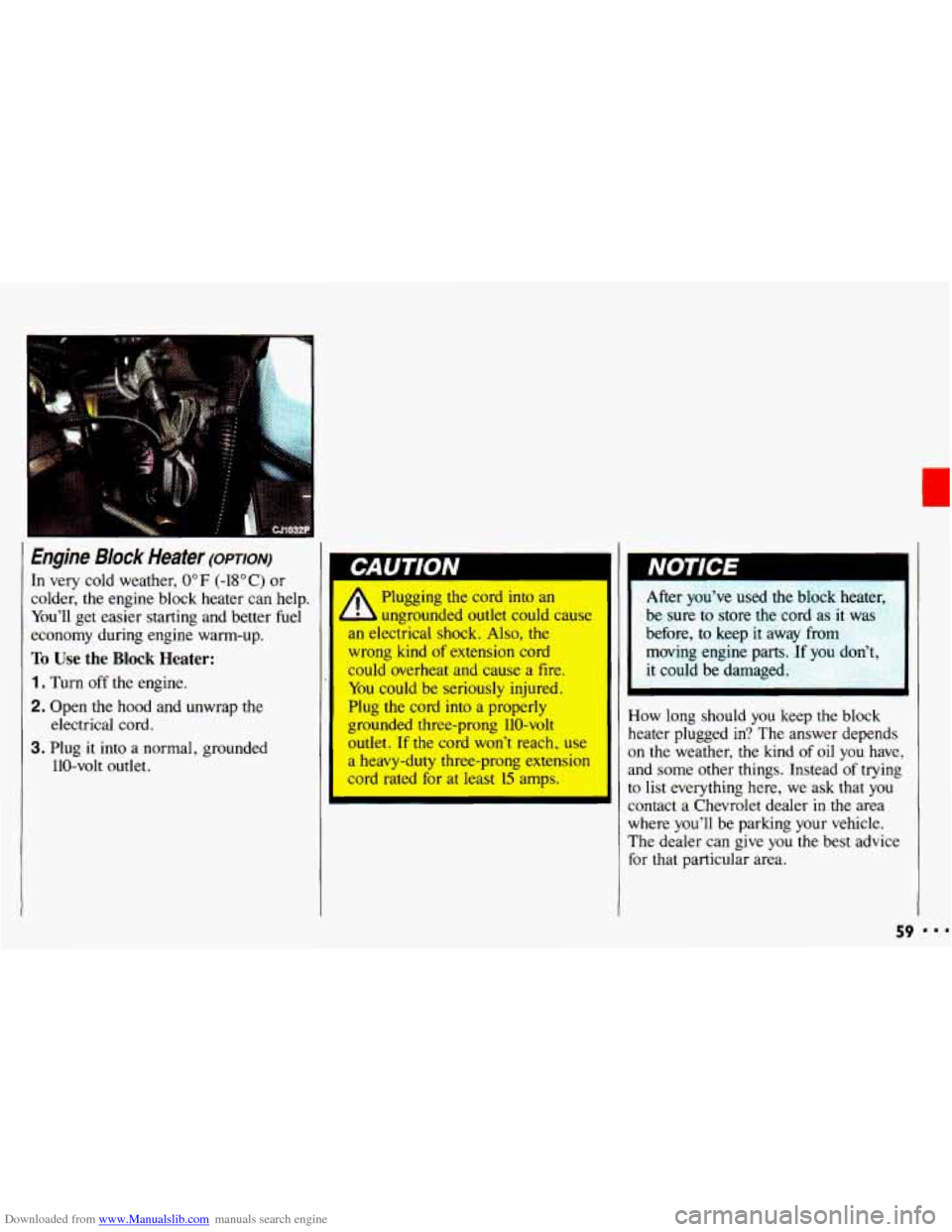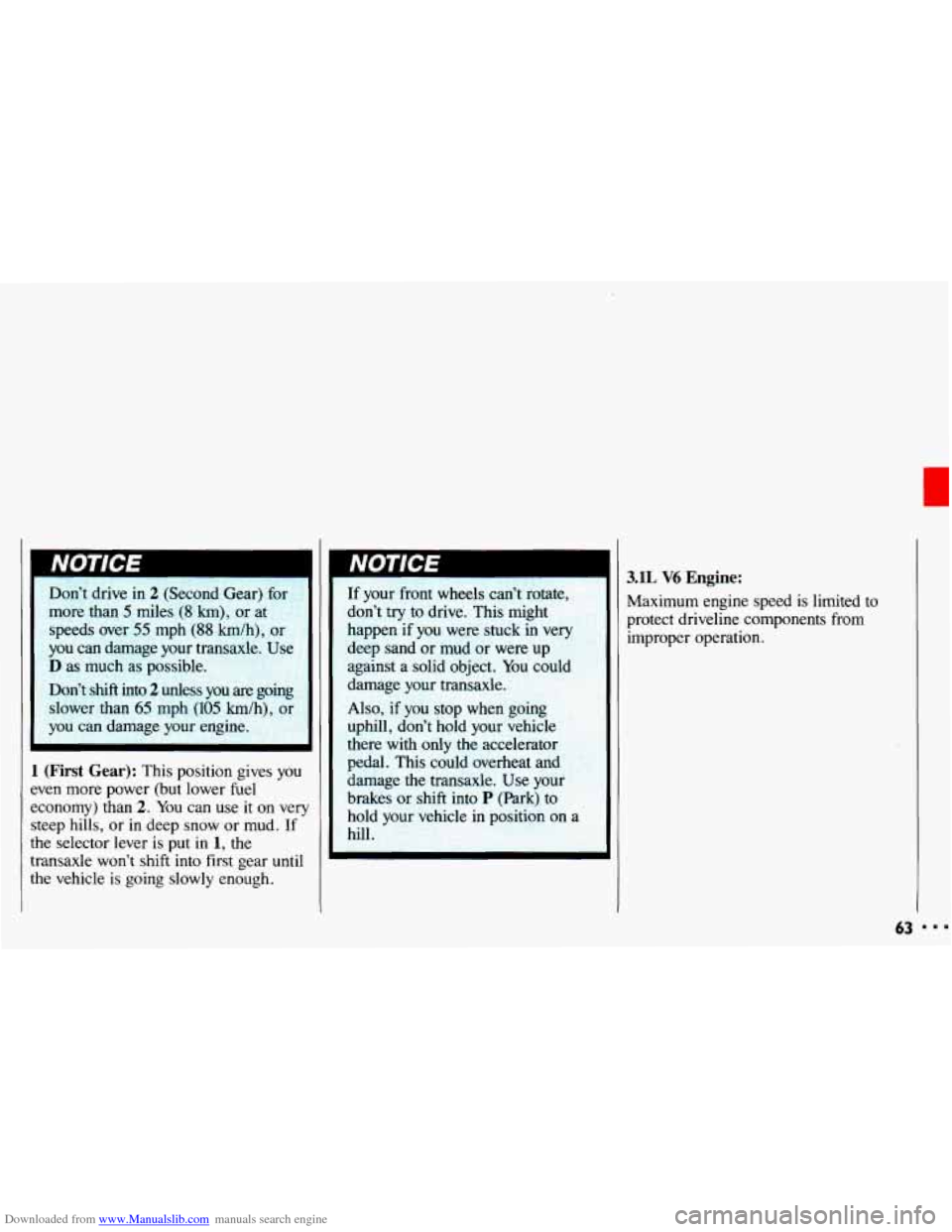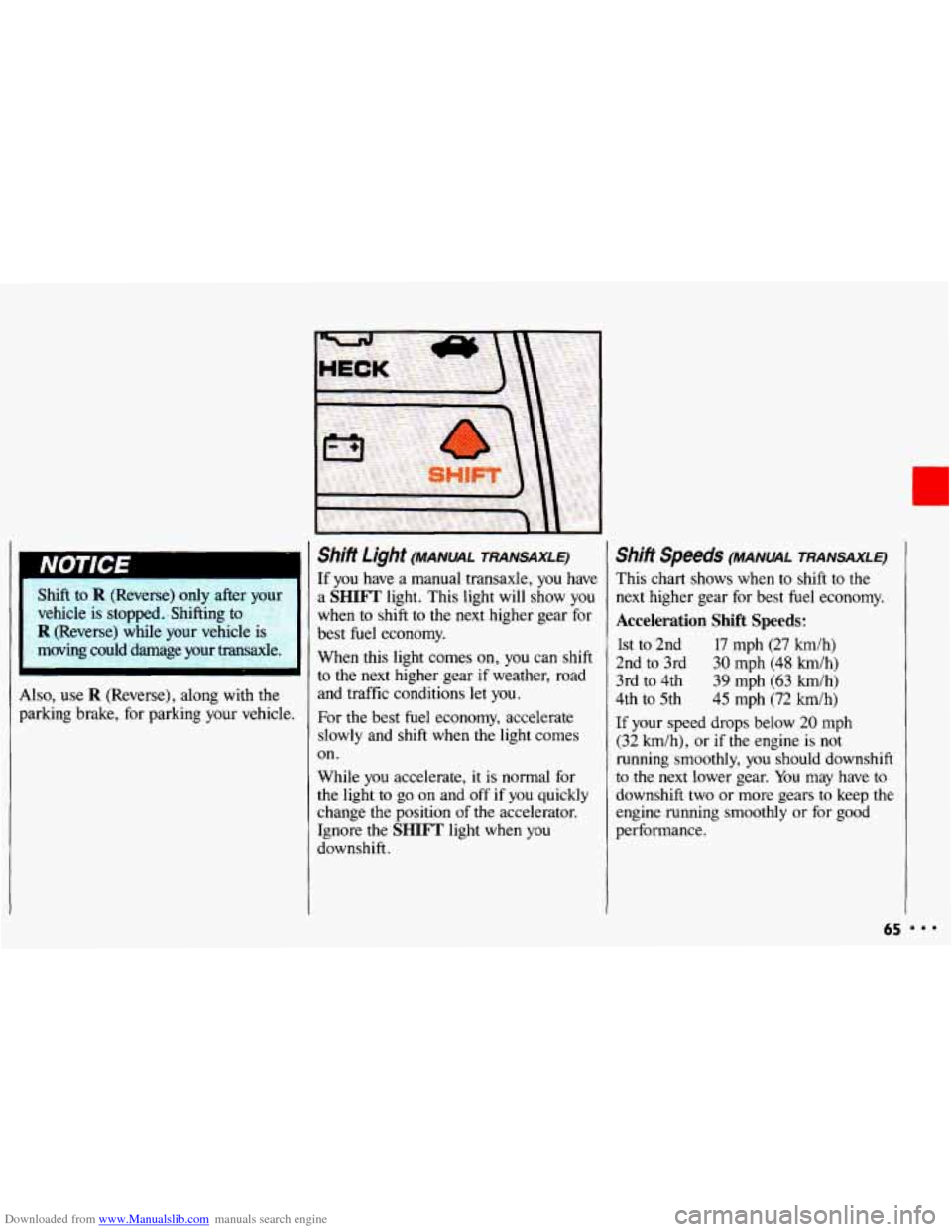Page 7 of 308
Downloaded from www.Manualslib.com manuals search engine The 1957 Chevy started a romance with the
American public-and was powered
by an
available fuel-injected
V8.
60's automotive excitement
included Chevrolet landmarks like
the Corvette Sting
Ray, the sporty
Camuro, and powerplants like the
legendary
327 V8.
m7
Your new Chevrolet continues a tradition of quality and value.
Page 11 of 308
Downloaded from www.Manualslib.com manuals search engine These symbols are on some of your
controls:
Windshield Wipers
Windshield Washer
Windshield Defroster
Rear Window Defogger Ventilating Fan
Power Window
These symbols are used on warning and Here are some other symbols you may
indicator lights: see:
Engine Coolant
Temperature
Battery Charging
System
Fuel
Engine Oil Pressure
Brake
Anti-Lock Brakes Fuse
- 1 Trunk Release
cc
Lighter
Horn
wbl
(@I
Hood Release
9
Page 60 of 308

Downloaded from www.Manualslib.com manuals search engine Features & Controls
60th Transaxles (CONI)
4. If your engine won’t start (or starts
but then stops), it could be flooded
with too much gasoline.
Try pushing
your accelerator pedal all the way to
the floor and holding it there as you
hold the key
in Start for about three
seconds. If the vehicle starts briefly
but then stops again, do the same
thing, but this time keep the pedal
down for five or six seconds. This
clears the extra gasoline from the
engine. Your
engine is designed to work
with the electronics in your
vehicle. If you add electrical parts
or accessories, you could change
the way the fuel injection system
operates. Before adding electrical
equipment, check with your dealer.
If you don’t, your engine might not
perform properly.
If you ever have to have your
vehicle towed, see the part
of this
manual that tells how
to do it
without damaging your vehicle.
See the
Index under Towing Your
Chevrolet.
kiving Through Deep Standing
Vater
IA!
If you drive too quickly through
deep puddles
or standing water,
water can come in through your
engine’s air intake and badly
damage your engine.
If you can’t
avoid deep puddles or standing
Page 61 of 308

Downloaded from www.Manualslib.com manuals search engine Engine Block Heater (OPTION)
In very cold weather, 0°F (-18°C) or
colder, the engine block heater can help.
You’ll get easier starting and better fuel
economy during engine warm-up.
To Use the Block Heater:
1. Turn off the engine.
2. Open the hood and unwrap the
3. Plug it into a normal, grounded
electrical cord.
110-volt
outlet.
A
Plugging the cord into an
ungrounded outlet could cause
an electrical shock. Also, the
wrong kind
of extension cord
could overheat and cause a
fire.
You could be seriously injured.
Plug the cord into a properly
grounded three-prong 110-volt
outlet.
If the cord won’t reach, use
a heavy-duty three-prong extension
cord rated for at least
15 amps. After
you’ve
used the bfock hea,,,
be sure to store the cord as it was
before, to keep it away from
moving engine parts. If
you don’t,
it could be damaged.
How long should
you keep the block
heater plugged in? The answer depends
on the weather, the
kind of oil you have,
and some other things. Instead of trying
to list everything here,
we ask that you
contact a Chevrolet dealer
in the area
where you’ll be parking
your vehicle.
The dealer can give
you the best advice
for that particular area.
59 I..
Page 64 of 308
Downloaded from www.Manualslib.com manuals search engine Features & Controls
Neutral (CONT:)
Shifting out of P (Park) or N
(Neutral) while your engine is
--racing” (running at high speed) is
dangerous. Unless your foot is
firmly on the brake pedal, your
vehicle could
move very rapidly.
You could lose control and hit
people or objects. Don’t shift out
of
P (Park) or N (Neutral) while
your engine is racing.
62
Damage to your transaxle caused
by shifting
out of P (Park) or $i;$JJ
N (Neutral) with the engine racing
isn’t covered
by your warranty.
Forward Gears
D (Drive): This position is for normal
driving.
2 (Second Gear): This position gives
you
more power but lower fuel
economy. You can
use 2 on hills. It can
help control your speed
as you go down
steep mountain roads, but then you
would also want to
use your brakes off
and on.
Page 65 of 308

Downloaded from www.Manualslib.com manuals search engine Don’t drive in 2 (Second Gear) fo
more than 5 miles (8 km), or at
speeds over
55 mph (88 km/h), or
you can damage your transaxle. U!
D as much as possible.
Don’t
shift into 2 unless you are going
slower than
65 mph (105 km/h),
you can damage your engine.
r I
1 (First Gear): This position gives you
even more power (but lower fuel II
If your front wheels can’t rotate,
don’t try to drive. This might
happen if
you were stuck in very
deep sand or mud or were up
against a solid object.
aula
damage your transal-’
Also, if you stop when going
uphill, don’t hold your vehicle
there with only
the accelerator
-
pedal. This cduld overheat and
damage the transaxle.
Use your
brakes or shift into
P (Park) to
hold lr vehicle
in position on a
hill.
economy)
than 2. You can use it crh very
steep hills, or in deep snow or mud. If
the selector lever is put in 1, the
transaxle won’t shift
into first gear until
the vehicle is going slowly enough.
3.lL V6 Engine:
Maximum engine speed is limited to
protect driveline components from
improper operation.
Page 67 of 308

Downloaded from www.Manualslib.com manuals search engine r
Shift to R (Reverse) only afte
vehicle is stopped. Shifting to
R (Reverse) while your vehicle is
moving could damage your transaxle.
Also, use
R (Reverse), along with the
parking brake,
for parking your vehicle.
Shift Light (MANUAL TRANSAXLE)
If you have a manual transaxle, you have
a
SHIFT light. This light will show you
when to shift to the next higher gear for
best fuel economy.
When this light comes
on, you can shift
to the next higher gear if weather, road
and traffic conditions let you.
For
the best fuel economy, accelerate
slowly and shift when the light comes
on.
While you accelerate,
it is normal for
the light
to go on and off if you quickly
change the position
of the accelerator.
Ignore the
SHIFT light when you
downshift.
Shifi Speeds (MANUAL TRANSAXLE)
This chart shows when to shift to the
next higher gear for best fuel economy.
Acceleration Shift Speeds:
1st to 2nd 17 mph (27 km/h)
2nd to 3rd
30 mph (48 km/h)
3rd to 4th 39 mph
(63 h/h)
4th
to 5th 45 mph (72 h/h)
If your speed drops below 20 mph
(32 h/h), or if the engine is not
running smoothly,
you should downshift
to the
next lower gear. You may have to
downshift
two or more gears to keep the
engine running smoothly or
for good
performance.
65
Page 95 of 308
Downloaded from www.Manualslib.com manuals search engine The lnstrument Panel-
Your information System
Your instrument panel is designed to let
you know at a glance how your vehicle
is running. You’ll know how fast you’re
going, how much fuel you’re using, and
many other things you’ll need to drive
safely and economically.
The main components
of your
instrument panel are:
1. Side Vents
2. Instrument Panel Intensity Control
3. Turn SignaVHeadlight Beam Lever
4. Hazard Warning Flashers Switch
5. Instrument Cluster
6. Ignition Switch
7. Windshield Wiper/Washer Controls
8. Interior Light Control
9. Audio System
1 0. Center Vents
1 1. Cup Holder
12. Side Vents
1 3. Glove Box
14. Climate Controls and Rear Window
1 5. Parking Brake Lever
16. Ashtray/Lighter
17. Gearshift Lever
18. Horn
19. Tilt Steering Wheel Lever
20. Fuse Panel
21 . Hood Release Lever Defogger
93 I..